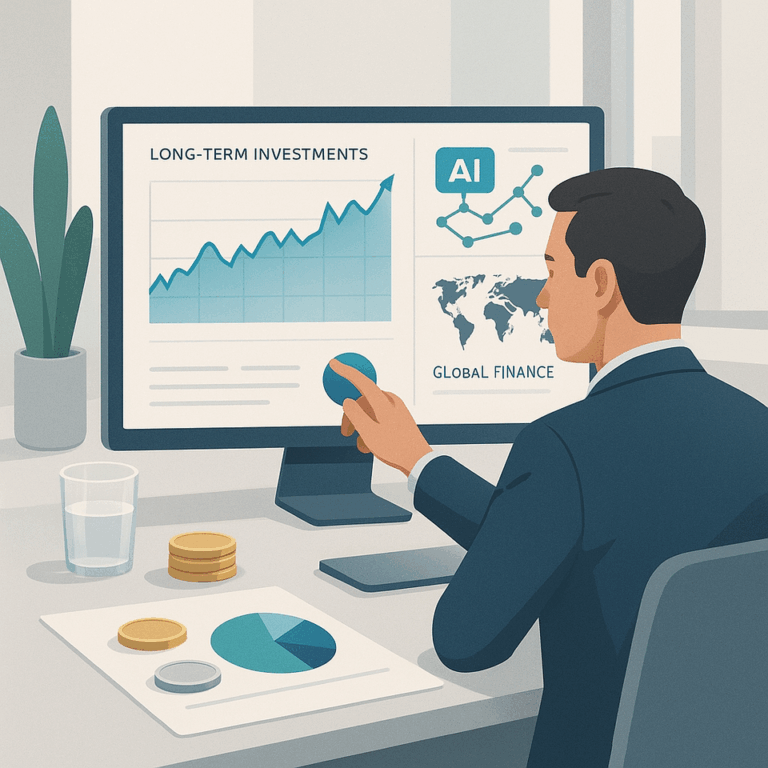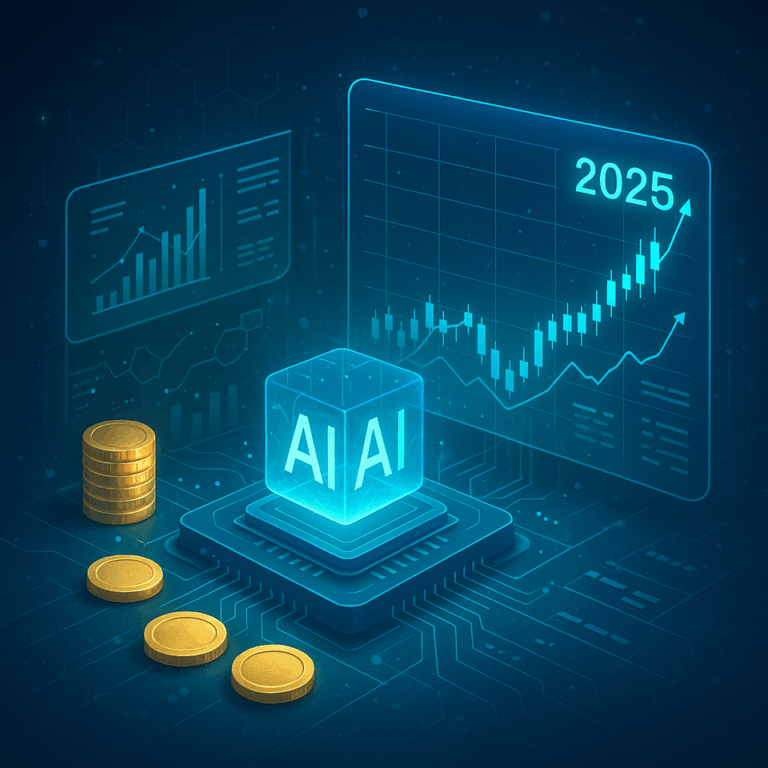Artificial intelligence in long-term investments represents a defining shift for modern investors. In 2025, market volatility and data complexity have increased dramatically. AI tools help address these challenges by supporting faster, more informed, and adaptive decisions.
Advanced analytics and automation now shape every step of the investment process. They allow investors to capture opportunities and manage risks that would be impossible to track manually. The integration of artificial intelligence in long-term investments is not just an innovation—it’s becoming essential for achieving stability and growth over time.
Defining Artificial Intelligence in the Context of Investment Management
Artificial intelligence (AI) refers to systems that think, learn, and process data like humans but at far greater speed and scale. In investment management, AI relies on machine learning algorithms to analyze massive datasets, natural language processing to gauge market sentiment, and predictive analytics to forecast performance.
These technologies power tools such as robo-advisors, trading platforms, and automated research engines. Investment managers use AI to handle repetitive analysis, detect hidden patterns, and adjust portfolio allocations with precision.
For example, an analyst might spend hours reviewing quarterly reports, while an AI system can evaluate thousands in seconds. It identifies market trends and anomalies before they become widely recognized, giving long-term investors a valuable advantage.
AI’s reach extends beyond analysis. It strengthens risk management, improves compliance, and enhances overall portfolio performance.
Key Drivers Behind the Adoption of AI in Long-Term Investment Strategies
Several factors explain why investors are rapidly adopting artificial intelligence:
Data Volume and Complexity: Financial markets now generate vast streams of data every second. AI filters the noise, highlighting real opportunities and risks.
Diverse Data Sources: AI incorporates nontraditional inputs such as social sentiment, weather data, and political developments, creating richer and more holistic analysis.
Speed and Precision: Markets react instantly to global news. AI allows near real-time execution and helps investors preserve long-term value through timely decisions.
Cost Reduction and Efficiency: Automating portfolio rebalancing, compliance checks, and reporting saves time and reduces costs. It lets firms focus on innovation instead of routine tasks.
Personalization: AI creates tailored strategies that match investor goals, risk tolerance, and ESG preferences, improving engagement and satisfaction.
Together, these drivers make AI indispensable for achieving sustained growth and operational agility.
How Leading Investors Use AI for Long-Term Growth
Top institutional investors—such as pension funds, sovereign wealth funds, and endowments—use AI at every stage of portfolio design.
Strategic Asset Allocation: AI models analyze macroeconomic trends, interest rate cycles, and sector signals to guide allocation decisions.
Tactical Adjustments: Machine learning monitors sentiment and market behavior, prompting timely reallocations that capture momentum and avoid losses.
Risk Modeling: Automated engines assess exposure, detect volatility spikes, and test portfolios under different economic scenarios.
Compliance and Reporting: AI-driven systems track rules, generate reports, and prevent breaches in real time.
For instance, BlackRock’s Aladdin platform processes vast datasets to give investors insights into risks and opportunities across markets. Smaller firms use third-party AI platforms to automate back-office operations, enhancing both accuracy and efficiency.
AI-Driven Tools Reshaping Portfolio Construction
The core of artificial intelligence in long-term investments lies in advanced digital platforms such as:
Robo-Advisors: Automated systems like Betterment and Wealthfront provide customized portfolios, continuous monitoring, and periodic rebalancing.
Sentiment Analysis Engines: These tools scan global media and online content to capture the mood around sectors or companies, identifying market turning points early.
Algorithmic Trading Systems: AI algorithms now optimize long-term strategies, not just short-term trades, executing complex decisions efficiently.
Alternative Data Analytics: By using satellite imagery, supply chain data, and other alternative sources, AI identifies subtle economic signals before they reach traditional reports.
Collectively, these innovations enhance precision, speed, and accessibility in long-term investment management.
Enhancing Risk Assessment and Monitoring Through AI
AI transforms how investors assess and control risk.
Early Warning Systems: AI detects unusual correlations or volatility patterns, allowing investors to act before risks escalate.
Continuous Oversight: Automated systems monitor portfolios 24/7, measuring metrics like drawdown probability and exposure to systemic events.
Scenario Simulations: AI models stress-test portfolios under a range of hypothetical market situations, identifying potential vulnerabilities.
Regulatory Compliance: Automated tools improve anti-money-laundering processes and transaction monitoring accuracy, reducing compliance burdens.
These capabilities let teams spend less time reacting to crises and more time refining long-term strategy.
Unlocking New Value Through Artificial Intelligence
When integrated effectively, AI creates new opportunities for investors and institutions alike.
Uncovering Hidden Trends: Algorithms detect emerging correlations and shifts that traditional models overlook.
Customized Portfolios: AI tailors strategies to investors’ unique financial goals, ethics, and timelines.
Operational Efficiency: Automation reduces manual workloads and improves accuracy, enabling faster decision-making.
Sustainability Alignment: AI helps investors evaluate environmental, social, and governance (ESG) factors with greater precision, aligning portfolios with long-term sustainability goals.
These advantages translate into improved performance, higher client trust, and stronger competitive positioning.
Risks, Limitations, and Challenges
Despite the benefits, AI-driven investing carries real challenges.
Transparency: Many models act as “black boxes,” making it difficult to explain how specific decisions are made.
Data Bias: Flawed or incomplete inputs can distort results, leading to poor outcomes.
Model Limitations: Algorithms trained on past data may struggle when conditions change dramatically.
Cybersecurity Risks: Greater digital interconnectivity exposes systems to hacking or operational failure.
Regulatory Shifts: As governments catch up to innovation, compliance requirements evolve rapidly.
To manage these risks, investors perform regular audits, enforce governance standards, and maintain human oversight at every step.
Building Effective AI Adoption Through Financial Education
Financial education remains essential to successful AI adoption.
Continuous Learning: Investors must understand AI’s logic, benefits, and weaknesses to use it wisely.
Evaluating Tools: Choosing the right platforms requires awareness of performance, transparency, and regulatory fit.
Adapting Workflows: Organizations must adjust processes and cultures to embrace data-driven decision-making.
Professional certifications, workshops, and cross-disciplinary training now focus on bridging finance and technology. As investors gain digital fluency, they can better question automated outputs and interpret complex insights with confidence.
The Regulatory Landscape for AI in 2025
The regulation of artificial intelligence in long-term investments is tightening worldwide. Authorities are enforcing standards for transparency, auditability, and ethical use.
Asset managers must validate their models regularly, document decisions, and maintain cybersecurity protections. Collaboration with regulators helps firms stay compliant and trusted.
Institutions like the Financial Stability Board and the Bank for International Settlements release ongoing guidance, helping investors adopt best practices while fostering responsible innovation.
Looking Ahead: The Future of AI in Long-Term Investing
The role of AI in investment will only grow stronger. In the coming years, it will evolve from a support tool into a strategic partner.
AI will not just analyze data—it will co-create investment strategies, offering adaptive solutions that reflect real-world dynamics. Its democratizing effect will also continue, giving smaller investors access to once-exclusive analytics.
The next generation of portfolio managers will blend financial insight with technical fluency. By mastering both human and machine intelligence, they will shape a financial ecosystem that is more transparent, inclusive, and resilient.



